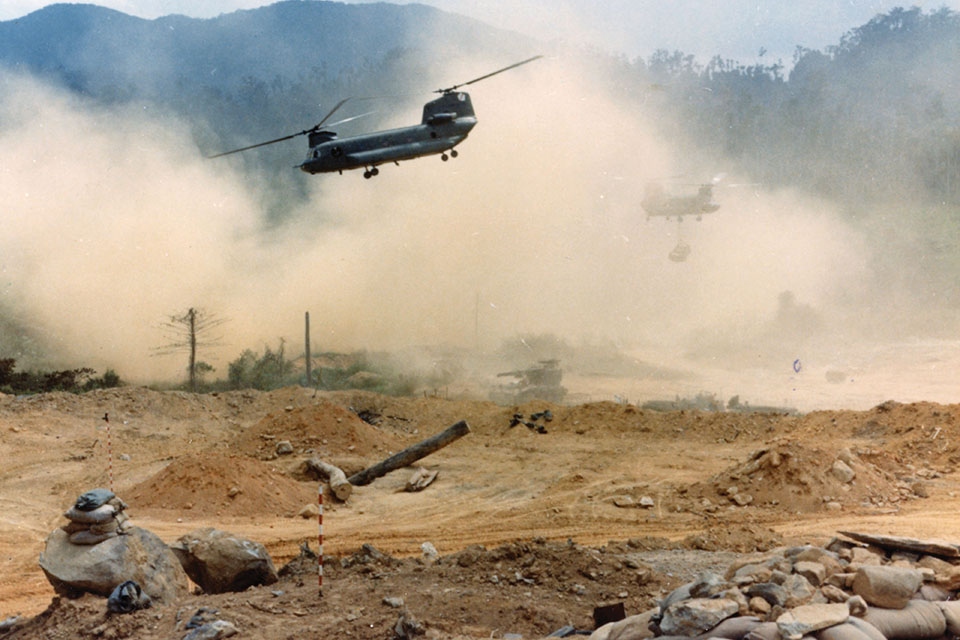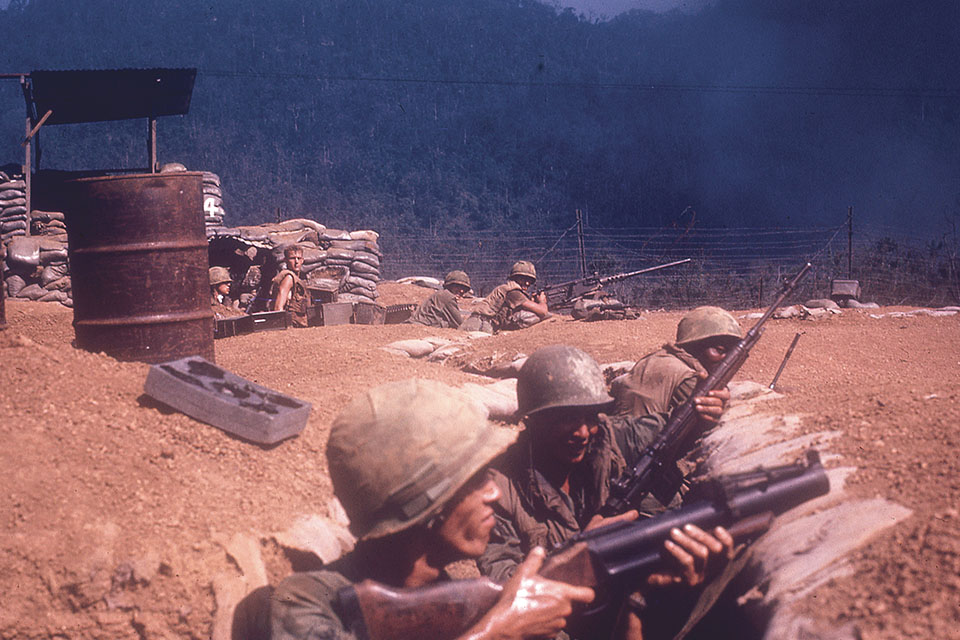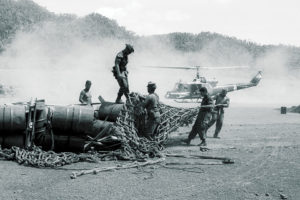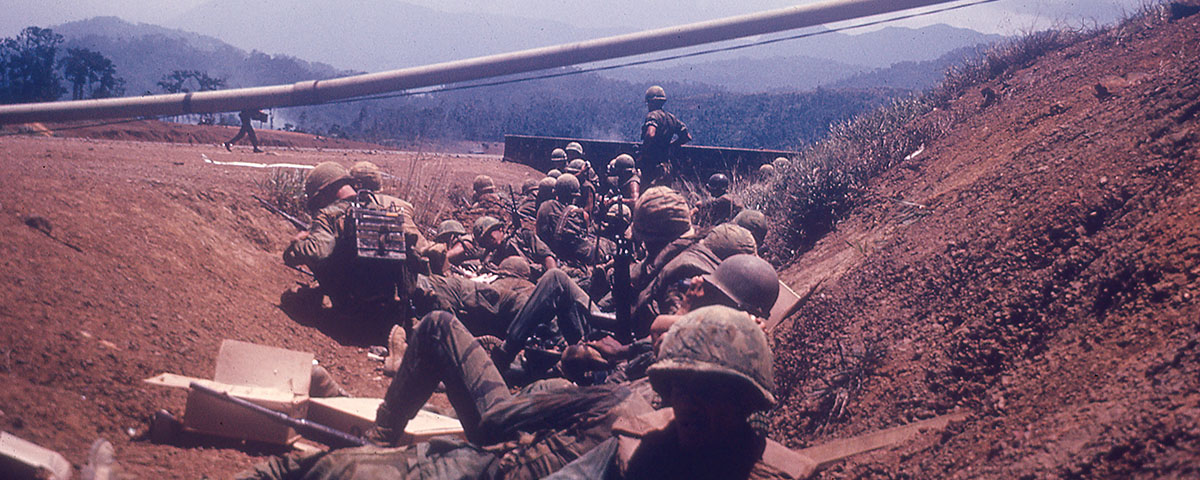In May 1968, more than 1,500 were surrounded by an advancing enemy at Kham Duc.
After Communist forces took a beating during their Tet Offensive that raged across South Vietnam in early 1968, the battered North Vietnamese Army and Viet Cong regrouped in the spring to try again with another series of widespread assaults. The NVA and VC hit about 120 sites in the May Offensive, or Mini-Tet. Two of those targets were the U.S. Army Special Forces camp at Kham Duc and the nearby outpost of Ngok Tavak, in the highlands of northern South Vietnam. The Green Berets and their local allies at the bases were surrounded and badly outnumbered. Courage, obstinacy, treachery by allies and luck—good and bad—played a role in the effort to save American troops during the May 10-12 battles.
By early March 1968, the most intense battles of the Tet Offensive, which began on Jan. 31, had ended. Around the same time, however, intelligence indicated increased NVA activity in the area near Kham Duc, about 60 miles southwest of Da Nang and 10 miles from Laos. Kham Duc housed a Special Forces camp established in 1963 next to an airfield surrounded by jungle-covered high ground. The camp was also a base for the clandestine operations of elite American units, which conducted reconnaissance missions and commando-style actions to disrupt the flow of enemy troops and supplies down the Ho Chi Minh Trail.
After Tet, elements of 2nd NVA Division around Kham Duc were strengthened as troops traveled down the Ho Chi Minh Trail with equipment that included flamethrowers, tear gas and anti-aircraft weapons. Kham Duc, positioned between the trail and major U.S. installations from Da Nang to Chu Lai, was a natural target—and a seemingly easy one, given the surrounding jungle-covered high ground and absence of supporting artillery.

To beef up security at the camp, the 5th Special Forces Group in Da Nang sent the 12th Mobile Strike Force, or Mike Force, a company of about 260 local Vietnamese of Chinese descent led by a Special Forces team, to Kham Duc in early March. Mike Forces were better trained and equipped units of Civilian Irregular Defense Groups, militias set up to protect villages from Viet Cong attacks. More support would arrive in April when 125 engineers in A Company, 70th Engineer Battalion, 937th Engineer Group, were deployed to Kham Du. Their work included extending the runway, providing all-weather navigation capabilities, clearing underbrush that could hide the enemy and forming a perimeter defense.
In a March 31 address, President Lyndon B. Johnson called for peace talks. The NVA and VC hoped the May Offensive they were planning would wear down U.S. and South Vietnamese forces, further dampen support for the war and enhance their position at the Paris Peace Talks, scheduled to begin May 10. A film crew was going to record what the NVA believed would be the “devastating defeat of American forces at Kham Duc” and a propaganda boon ahead of the talks, according to a North Vietnamese cameraman in a 1995 interview with U.S. Defense Department researchers in Ho Chi Minh City.
American commanders were still uncertain about the 2nd NVA Division’s exact location. In mid-March, the 11th Mobile Strike Force of the 5th Special Forces Group was ordered to Ngok Tavak, an abandoned French fort 4 miles south of Kham Duc, to conduct recon patrols in the area. The Mike Force comprised 122 ethnic Chinese, three U.S. and three South Vietnamese Special Forces troops, three interpreters and three officers in an Australian team led by Capt. John White.
Throughout April, White’s patrols encountered and battled NVA units. In one firefight, CIDG soldiers left their Australian advisers to fend for themselves, raising doubts about the local force’s reliability as an ally. On May 3, a captured North Vietnamese soldier confirmed that the 2nd NVA Division was preparing for an attack—and had infiltrated the CIDG at Kham Duc.
White planned to evacuate the small garrison at Ngok Tavak, since his troops had clearly achieved their mission and “found” the NVA, which now also knew his location. But the captain got a surprise in early May when the 2nd Marine Division’s 13th Marine Regiment sent in an artillery platoon of 43 Marines and a Navy hospital corpsman from D Battery. On May 9, the Marines lugged a pair of 105 mm howitzers into position. The arrival of artillery to protect Kham Duc made Ngok Tavak the NVA’s first target.
Friday, May 10
As the moon set at 3 a.m., the NVA unleashed a a a mortar barrage on Ngok Tavak. One CIDG unit that White kept outside the perimeter, because its allegiance was suspect, came to the entrance. “Don’t shoot, friendly,” they called out, but then threw explosive-filled satchels, killing several Marines inside the garrison and knocking the howitzers out of commission. NVA flamethrowers surged forward and lit a vehicle on fire.
At 4:20 a.m., an AC-47 “Spooky” gunship arrived overhead and fired its three multi-barrel 7.62 mm machine guns on the attackers. NVA troops tried to use tear gas, but the wind blew it back onto their own positions. Half the attackers then shifted north to assault Kham Duc, leaving only a Viet Cong force to deal with Ngok Tavak’s remaining defenders.
Marine helicopters from Kham Duc brought reinforcements, but rocket-propelled grenades hit two of them on the landing zone, rendering the helos and the landing zone unusable. White had 70 wounded that his men could not carry out on foot, so he called for a medevac helicopter. Maj. Pat Brady made multiple flights from Kham Duc to move the wounded.
Despite the precarious situation, 5th Special Forces headquarters ordered White to hold for reinforcements, but he knew that was impossible. The enemy had destroyed the landing zone and blocked the road to Kham Duc. Water and ammunition were running short.
To clear an escape route, White called for napalm strikes down the pathway of the main attack and then led his surviving troops—83 CIDG, three Australian, five Special Forces and 14 Marines—along the burning pathway. Marine helicopters picked up the escapees and landed them at Kham Duc by 6:30 p.m.
The attack on Ngok Tavak killed 16 Americans and wounded 23. The CIDG tally was 30 killed or wounded and 64 missing, including those who deserted.
Soon after the North Vietnamese attacks began, the 23rd Infantry Division (Americal) initiated Operation Golden Valley to reinforce Kham Duc. The U.S. Air Force provided C-130 transport planes to move men and equipment to the camp, often under mortar fire. The Air Force landed a “combat control team” acting as air traffic controllers to coordinate the increasing number of arrivals and departures. Maj. John Gallagher, a C-130 pilot, was in charge of the team, which consisted of Tech. Sgts. Norton Freedman and James Lundy and a liaison officer to coordinate the air operations with the infantry at Kham Duc.
Troops from Americal’s A Company, 1st Battalion, 46th Infantry Regiment, 198th Light Infantry Brigade landed by 10:50 a.m. and established defensive positions. Seven observation posts had previously been positioned around Kham Duc. Two were no longer in use. Squads from A Company went to observation posts 1, 2 and 5. CIDG forces occupied the remaining two.
By the end of the day, the Air Force had also flown in 571 men of the division’s 2nd Battalion, 1st Infantry Regiment, and 57 men of Battery A, 3rd Battalion, 82nd Field Artillery Regiment, which came with two howitzers. The 2nd Battalion commander, Lt. Col. Robert Nelson, positioned troops along the perimeter and had engineers bulldoze trenches for artillery firing positions and the battalion command post. Three more howitzers would arrive the next day.
Saturday, May 11
At dawn, the troops went to work strengthening Kham Duc’s defenses, and Nelson moved 2nd Lt. Frederick Ransbottom’s E Company, 2nd Battalion, 1st Infantry, to observation posts 1, 2 and 5, relieving the squads of A Company, 1st Battalion, 46th Infantry.
Thirty B-52 bombers struck probable NVA positions around the camp, but the enemy mortar attacks continued. When the American artillery responded, the howitzers’ muzzle flashes revealed their position to the NVA, which then scored a direct hit on one of the howitzers, killing two and wounding 35.
Meanwhile, many of the top commanders in Vietnam worked on a strategy to deal with the attack. The discussions included Maj. Gen. Samuel W. Koster of the Americal Division, Lt. Gen. Robert E. Cushman of the 3rd
Marine Amphibious Force, Col. Jonathan F. Ladd of U.S. Special Forces and Gen. Creighton Abrams of Military Assistance Command, Vietnam. They sent Gen. William Westmoreland, the overall American commander in Vietnam, a recommendation, which he accepted, to “relocate” the camp because of its poor defensive position.
The evacuation would occur over three days, according to the plan. But it took nearly a day to communicate the decision to all the elements supporting Kham Duc. By the end of Saturday, more than 1,500 troops and 300 civilian dependents were in Kam Duc. The military units included U.S. Special Forces, ethnic Chinese CIDG militiamen, combat engineers, Air Force air traffic controllers, infantry and artillerymen.

Sunday May 12
Around 3 a.m. the NVA began new assaults on the observation posts. At OP 2, Ransbottom reported he was killing the North Vietnamese as fast as they were entering—but then went silent. Nelson ordered everyone at the observation posts to pull back, but as the sun rose, all the observation posts had been overrun. Survivors at OP 2 withdrew toward the airstrip.
As the NVA advanced on OP 1, Spc. 4 Bill Wright, a radio telephone operator, grabbed an incapacitated Sgt. Orlando Vasquez and began dragging him back to the camp. He also established radio contact with the battalion executive officer, Maj. Don Buchwald, and directed airstrikes to cover their withdrawal. When he spotted a North Vietnamese company moving through the high sawgrass toward the camp, Wright directed napalm strikes that stopped the NVA troops.
From another bunker at OP 1, Spc. 4 Julius Long and Sgt. Joseph Simpson began their 350-meter scramble to the camp. Simpson was killed 100 meters from the bunker, and NVA troops blocked Long’s path, forcing him out of sight to avoid discovery.
At a 4 a.m. briefing, Nelson announced that the three-day evacuation plan had been discarded and everybody was to be extracted that day. The priority order would be: engineers, CIDG families, Special Forces, artillerymen, infantry and CIDG troops. They would take out only handheld weapons and destroy all other equipment.
At 5:20 a.m., Air Force Capt. William Spier, a forward air controller in a O-2 Skymaster, directed F-4 Phantom II fighter-bombers to attack advancing NVA units. When an impenetrable ground fog blocked Spier’s view, Special Forces troops adjusted the airstrikes based on the sound of the impacts. The fog lifted around 7:30 am, but Spier was running low on fuel and passed his airstrike control duties to Capt. Paul Judge.

A flight of CH-47 Chinook helicopters arrived to begin the evacuation. Capt. Joe Sturdevant was flying past OP 7 near the runway’s north end when the NVA’s 12.7 mm guns opened up. The Chinook faltered and crashed, but the crew escaped. The other Chinooks flew to Chu Lai to take on additional gun crews before returning.
The burning wreckage of Sturdevant’s Chinook blocked the runway, and engineers began clearing it away. Because they had disassembled their bulldozer for the evacuation, the engineers tried to use a bucket loader. But its tires caught fire from burning helicopter fuel. They had to reassemble the bulldozer and brave mortar fire for an hour while clearing the airstrip.
Shortly after 8 a.m., NVA anti-aircraft guns placed on the overrun OP 1 shot down Air Force Maj. James Swain’s A-1E Skyraider attack plane, which was providing air support for the evacuation. He parachuted and landed outside the perimeter. A Huey piloted by Warrant Officer Ed Fitzsimmons picked up Swain while two other Hueys provided suppressing fire. Airstrikes on the enemy-held observation posts silenced the artillery fire, but only until the NVA replaced the killed crews.
The Air Force sent in a C-130 airborne command center, which worked with Nelson on the ground and forward air controllers in the sky to organize about 200 tactical airstrikes. The command center also coordinated the Air Force transports and the aerial refueling operations with a KC-135 tanker.
By 10 a.m., the engineers had almost cleared the runway when Lt. Col. Daryl Cole landed a C-130 full of supplies. In the confusion, he was unaware the mission had changed from “reinforcement” to “emergency evacuation.” Mortar fire damaged Cole’s wing fuel tanks and blew out a tire. But when the C-130 rolled to a stop, local CIDG families rushed aboard. Cole tried to take off but couldn’t gain enough speed because of the cargo, passengers and blown tire. He aborted and shut down the engines. The families got off the plane.
During that time, the Air Force decided that it was “completely unfeasible” to carry out evacuations with C-130s, and passed the word to Gallagher, the pilot in charge of the combat control team. The team members got aboard Cole’s repaired aircraft. Mortar fire blew out the cockpit windows during takeoff, but the C-130 made it to Cam Ranh Bay.
At 11:15 a.m., Maj. Ray Shelton landed his C-123 transport plane and boarded 44 engineers and some civilians. “He was rolling as I jumped on,” recalled James Beer, a surveyor with the 70th Engineer Battalion. Taking off, Shelton reported ground fire from “every quadrant.”
Capt. Phillip Smotherman, a forward air controller in an O-2 Skymaster, had his wing shot off and crash-landed on the airstrip. He was now the only Air Force officer on the ground and appointed the air liaison officer. Lt. Col. Ray Carson, commander of Americal’s 14th Combat Aviation Battalion, circled overhead to coordinate the Army’s aviation units. Medevac Hueys made many trips for the seriously wounded, and Chinooks continued the evacuation, but progress was slow. At 1 p.m., there was an order to resume C-130 flights to speed up the evacuations.
At Cam Ranh Bay, Air Force Maj. Jay Van Cleef had a load of supplies he was going to airdrop at Kham Duc because it was too dangerous to land. But instead he was ordered to return the combat control team to Kham Duc. Gallagher objected: There was no evacuation to control. Nonetheless, Van Cleef set off for Kham Duc with Gallagher, Lundy and Freedman onboard.
Two Huey gunships accompanying a medevac copter at Kham Duc were shot down at 1:50 p.m. but managed to land, one at the airfield. Minutes later, Warrant Officer Larry Kemp’s Chinook full of troops from A Company, 1st Battalion, 46th Infantry, was shot down as it was climbing out. Despite a hard landing from 400 feet and a fire, everyone escaped except Pvt. Richard Sands, killed by a 12.7 mm round. Kemp was able to start the shot-up helicopter and left Kham Duc.
C-130 flights resumed around 3 p.m. with an aircraft flown by Maj. Bernard Bucher. He took off with 150 civilians and Special Forces Capt. Warren Orr, but previously silenced anti-aircraft guns on OP 7 opened fire and downed Bucher’s plane. There were no survivors. Soon U.S. airstrikes again halted the enemy fire.
While approaching Kham Duc, C-130 pilot Lt. Col. William Boyd saw tracers hammering Bucher’s aircraft. He landed, a hundred troops quickly boarded, and he took off through mortar, rocket and small-arms fire. After the flight, Boyd counted more than 100 bullet holes in his plane and dubbed it the “Lucky Duc.”
Three other C-130s landed through mortar fire and evacuated a total of nearly 370 people. As Hueys and Chinooks completed their 41st mission, taking out an additional 900, ground troops set demolition charges on the remaining equipment and bunkers. Maj. James Wallace’s C-130 evacuated the last personnel on the ground: the Americal command group, Special Forces members and Smotherman, the new air liaison officer.
Moments later, Van Cleef, following his earlier orders, returned to Kham Duc with the combat control team. Gallagher, Lundy and Freedman headed to the Special Forces bunkers, now aflame, then went to the Americal headquarters, already abandoned. With mortar fire creeping closer to the C-130, Van Cleef took off and reported that he had landed the combat control team. Now there were more men to evacuate.
Lt. Col. Alfred Jeanotte’s C-123 flew in to retrieve the team, whose exact location was not known. After the aircraft landed, the team moved toward it, but the crew didn’t see the men. Jeanotte, taking heavy fire, flew out. During the climb one of his crew spotted the team and gave the location to the next C-123 in the stack, piloted by Lt. Col. Joe Jackson.
Jackson made a steep descent and landed under extremely difficult conditions. As the combat control team boarded, a 122 mm rocket, fired from the northern ridgeline, skidded down the runway toward the aircraft and stopped 30 feet short of the nose wheel. Jackson turned the C-123 and took off. His courage was later recognized with the Medal of Honor. The air evacuation on May 12 was complete, just as a rainstorm closed the runway to any further air traffic.
Additional B-52 strikes over the next three days severely punished the massed NVA forces.
The casualty count for the Americans at Kham Dcu was 27 killed, more than 100 wounded and one captured.
Long, who had gotten out of OP 1 but had his route to the camp blocked by the NVA, evaded the enemy until he saw an American jeep on May 16. He approached the vehicle, only to discover it had been commandeered by NVA soldiers. Long spent three years in hellish prisoner of war camps around Kham Duc before being marched to Hanoi. He was released with other American POWs in March 1973, after the peace agreement ending the war.
Also, on May 16, a Marine helicopter with gunship escorts rescued three wounded soldiers who had escaped from OP 2—Sgt. Ed Sassenberger, Pvt. John Colonna and Spc. 4 William Foreman—after their “pick us up” sign was spotted at the eastern end of the airfield.
Troops from the 2nd Battalion, 1st Infantry Regiment, and South Vietnamese units returned to Kham Duc in July and August 1970 and recovered some remains of the Americans killed in the observation posts. Returning from a search mission, one aircraft was shot down near its landing zone, killing all 26 on board and one on the ground.
After the war, former Marine Lance Cpl. Tim Brown, who had been evacuated from Ngok Tavak on May 8 for medical reasons, worked with the Vietnamese for many years to search the site for remains. The American bodies were recovered in 2005 and interred in Arlington National Cemetery.
In March 2006, the remains of Ransbottom and his radioman, “Skip” Skivington, were identified in their OP 2 bunker. The remains of Bucher’s C-130 crew and Orr, the Special Forces captain, were recovered in 2008 and interred at Arlington.
—Roger Mulock was a first lieutenant in the headquarters of the 2nd Battalion, 1st Infantry Regiment, 196th Light Infantry Brigade, Americal Division, from April to September 1968. During the fighting at Kham Duc, Lt. Col. Robert Nelson ordered him to “get a radio, go out and report on what you see.”





